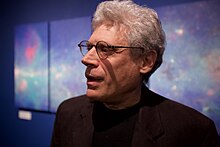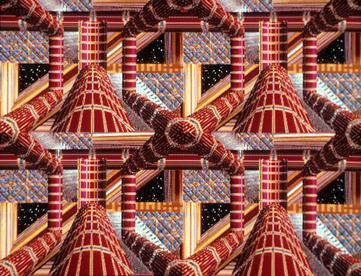David Em
David Em | |
|---|---|
 David Em at his "The Shape of the Universe" exhibition, 2011 | |
| Born | 1952 Los Angeles, California, USA |
| Nationality | American |
| Education | Pennsylvania Academy of the Fine Arts American Film Institute |
| Known for | Digital art |
David Em (born 1952) is an American artist known for his pioneering breakthroughs in computer art.
Life and work
David Em was born in Los Angeles and grew up in South America. He studied painting at the Pennsylvania Academy of the Fine Arts and film directing at the American Film Institute.
Em created his first digital painting at the Xerox Palo Alto Research Center (Xerox PARC) in 1975 with SuperPaint, "the first complete digital paint system".[1]
In 1976, he designed an articulated 3D digital insect at Information International, Inc. that could walk, jump, and fly, the first 3D character created by a fine artist.[2]
Em became the first artist to produce navigable virtual worlds in 1977 at NASA’s Jet Propulsion Laboratory (JPL), where he was Artist in Residence from 1976 to 1988.[3] He also created digital art at the California Institute of Technology (1985 – 1988), and Apple Computer (1991).[4] Em has worked independently since the early 1990s.
Scope of work
David Em's creative activities exist outside of the mainstream art world. His work is independent of any group or movement.
Em's art spans multiple media, including virtual worlds, filmmaking, photography, and printmaking. He has also worked with live performance and theater.[5]
He says he "makes pictures with electronic light, sculpts with memory”, [6] and "evolves images that grow into and out of each other”.[7]
Stylistically, Em's art has connections to Surrealism, abstract painting, and experimental film. Gardner's Art Through the Ages describes his work as "futuristic geometric versions of Surrealistic dreamscapes in which the forms seem familiar and strange at the same time."[8]
Some of his early art created at the Jet Propulsion Laboratory incorporates deep-space themes. In the 1980s he produced light effects reminiscent of the French Impressionists, and in the 1990s he introduced otherworldly lifeforms into his images. His current work relates to the neurosciences and consciousness.
Reception
During the early stages of Em's career, most people did not believe computers could be used for creative purposes. Em's widely disseminated digital images helped reverse that perception. [9]According to the Digital Art Museum's web site, "His piece Transjovian Pipeline (1979) became one of the most reproduced artworks in the 1980s."[10]
Em had several noted early supporters, including the author Ray Bradbury, who dedicated a poem to Em's work titled "Em Squared", in which he wrote, "He is preeminent in a field that is as swiftly flowing and changing as a storm stabbing its way across country walking on stilts of electric fire."[11]
In a feature article on his work in Smithsonian Magazine, editor Paul Trachtman stated that “Em’s images…may be the art world’s equivalent of astronaut Neil Armstrong’s footstep on the moon." [12]Whitney Museum of Art director David Ross wrote a monograph about Em's art in which he said, "His electronic creations have redefined the territory of technological art."[13]
Subsequently, his art was written about and published in many international publications, including Time, Newsweek, The New York Times, the Los Angeles Times, The Boston Globe, Der Spiegel, and many others. His images have been exhibited and presented internationally, including at the Centre Pompidou, the Musee d’Art Moderne de la Ville de Paris, Harvard's Carpenter Center for the Visual Arts, MIT, the Museum of Contemporary Art, Los Angeles, and the Academy of Motion Pictures Arts and Sciences. Em's art has also appeared in popular media, including the covers of Herbie Hancock's Future Shock, Sound-System, and Perfect Machine albums and an electronic version of William Gibson’s Neuromancer.
David Em is the first digital artist to have his working papers acquired by the Smithsonian Archives of American Art.
Current Life
David Em lives and works in Los Angeles. He rarely exhibits or makes public appearances.
Notes
- ^ Perry, T. & Wallich, P.:"Inside the PARC: The Information Architects", Pages 68-69, "IEEE Spectrum", October 1985
- ^ Sorensen, P. "Computer Pictures", "David Em Modern Master" May 1988
- ^ Nelson, Ted "Creative Computing", "Report on Siggraph '81", March 1982
- ^ Haggerty, M. "IEEE Computer Graphics and Applications" page 4 "Computer Painting in a Different Light." Nov. 1992
- ^ Michie, Donald and Rory Johnston. “The Creative Computer”, Viking, 1984, pp. 139-140
- ^ Deken, Joseph “Computer Images: State of the Art,” , Stewart, Tabori, and Chang, 1983, page 133
- ^ Wands, Bruce. “Art of the Digital Age”, Thames and Hudson, 2006, page 48
- ^ Kleiner, Fred "Gardner's Art Through the Ages: A Global History," Harcourt Brace Jovanovich, 2018
- ^ https://www.davidem.com/field-notes/
- ^ https://dam.org/museum/artists_ui/artists/em-david/
- ^ Bradbury, Ray. "Em Squared". Orange County Center for Contemporary Art. 1984
- ^ Trachtman, Paul. "An Impressionist with a Computer". Smithsonian Magazine. 1988
- ^ Ross, David A. "The Art of David Em", Abrams, 1988
Further reading
- Crowther, Paul (2019). Digital Art, Aesthetic Creation. New York and London: Routledge.
- Vacheron, Joel (2018). "Interview with David Em". Switzerland: IdPure Magazine #39.
{{cite journal}}: Cite journal requires|journal=(help) - Kleiner, Fred S.; Mamiya, Christin J. (2018). Gardner's Art Through the Ages (16th ed.). Harcourt Brace Jovanovich.
- Gardiner, Jeremy; Malone, Seamus; Lambert, Nick (February 24, 2009). "Interview with David Em". Computer Art & Technoculture. London.
- Zelanski, Paul; Fisher, Mary Pat (2007). The Art of Seeing (7th ed.). Upper Saddle River, NJ: Pearson Prentice Hall.
- Ross, David (1988). The Art of David Em. New York: Harry N. Abrams.
- Bradbury, Ray (1984). "Em Squared". David Em at OCCA (exhibition catalogue). Orange County Center for Contemporary Art.

